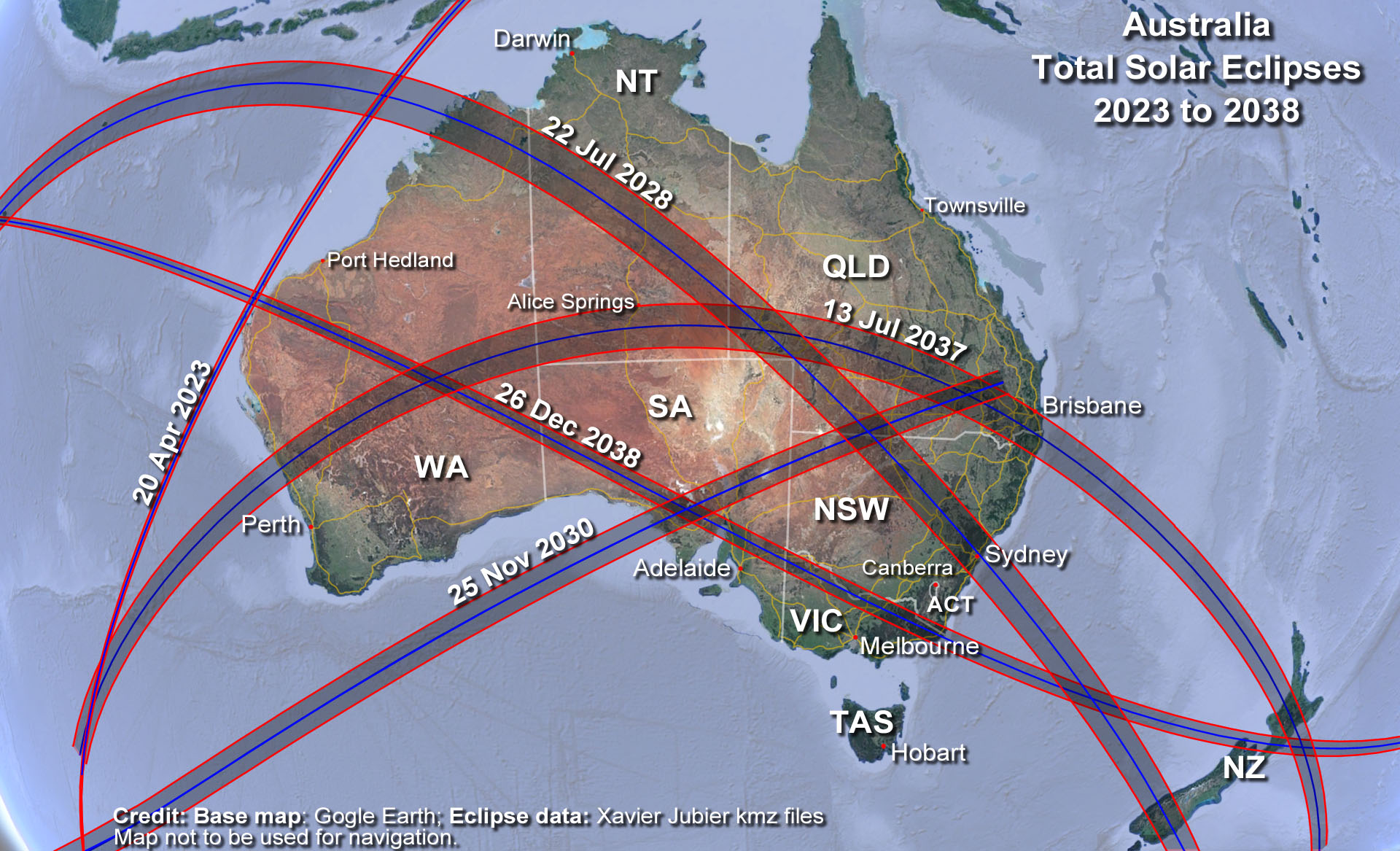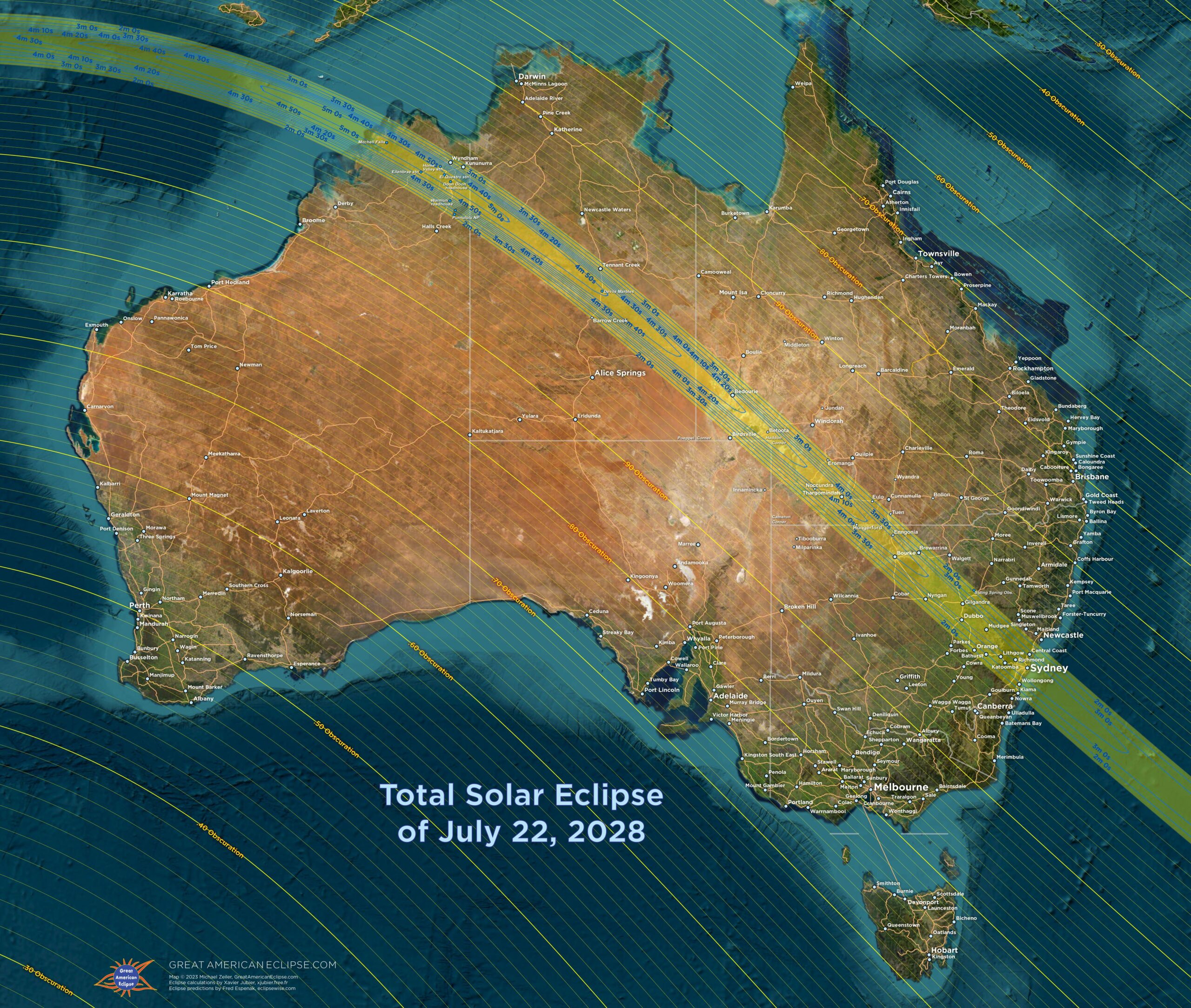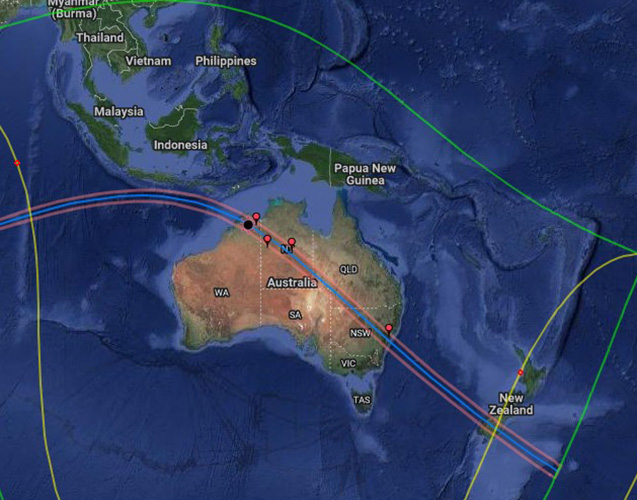COUNTDOWN TO TOTALITY* 22.07.28
Day(s)
:
Hour(s)
:
Minute(s)
:
Second(s)
The Australian Solar Eclipse 22 July 2028
A total solar eclipse will occur right across Australia on 22 July 2028. This is the second in a series of five total solar eclipses in Australia between 2023 and 2028. The first was on 20 April 2023.
*The countdown timer above is set for 22 July 2028.
The path of the total eclipse on the Australian mainland will cross the Kimberley region of Western Australia then continue on across the Northern Territory, south-west Queensland and into New South Wales passing directly over Sydney. The eclipse will be total at around 11am (AWST) in the Kimberley area, around 12:45pm (ACST) in the Northern Territory and around 2pm (AEST) in Sydney.
The process of the moon moving across the face of the Sun takes up to about three hours, but the time of totality, when the Sun is completely obscured by the moon will only last for up to a little over 5 minutes in the Kimberley area to up to 3 minutes and 45 seconds in the Sydney area (exact times depend on your location).
Check the interactive map further down the page to see the path of the total eclipse across Australia and the time of the eclipse at any observing location on the path. Zoom in and click on the location to show a pop up box with the time and duration of the total eclipse as well as the times of the start and end of the partial phases. Note that the times are in Universal Time, but that can be changed to local time by clicking on the clock icon on the left hand side of the screen. The altitude of the Sun as well as its direction is also shown.
The timing of the total eclipse at selected locations along the path of totality are listed HERE.
This rare and spectacular phenomenon is probably the most awe inspiring event in the natural world.
Observers at the 2028 Total Eclipse can expect to see the Sun’s bright disc slowly being covered by the silhouette of the moon to produce a diminishing solar crescent.
Just as the last of the Sun disappears behind the moon, two interesting optical phenomenon will occur, known as Baily’s Beads and the Diamond Ring Effect. This is when the final rays of sunlight pass between the rugged lunar topography.
See HERE for a description of the total solar eclipse experience.
Michael Zeiler /GreatAmericanEclipse.com
The path across Australia of the solar eclipse on 22 July 2028.
The path of totality is highlighted in yellow with the duration of totality indicated. Yellow lines roughly parallel to the path of totality show the maximum amount of obscuration of the sun away from the path of totality. Obscuration is the percentage area of the Sun covered and is an indication of the degree of reduction in sunlight.
At the same time, the whole of Australia will experience a partial solar eclipse – a solar eclipse seen from within the Moon’s penumbra, where the Moon appears to block part (but not all) of the Sun’s surface (the photosphere).
During a partial eclipse there is some reduction in brightness due to the Moon covering the Sun’s disc. However this is usually not noticeable unless the reduction is large.
The interactive map below will show you how much of the Sun’s disc will be blocked at any location across Australia. Zoom in and click on any location outside the path of totality to show a pop up box with the timing of the start and end of the partial eclipse and maximum coverage of the Sun. Note that the times are in Universal Time, but that can be changed to local time by clicking on the clock icon on the left hand side of the screen. The altitude of the Sun as well as its direction is also shown. The magnitude figure is the maximum coverage of the diameter of the Sun at the location.
The timing and maximum coverage of the Sun for the partial eclipse at capital cities are listed HERE.
Do not look at a partial eclipse or the partial phases of a total eclipse – use eclipse glasses or a projection method as described HERE.
See HERE for what to expect during a partial eclipse.
Interactive Google Map – showing the path of the eclipse (map opens in new window)
Google Maps / Xavier M. Jubier
AUSTRALIA’S ECLIPSE QUINTET: 2023-2038
There are five total solar eclipses visible in Australia over the 15 year period 2023 to 2038. Following the recent 20 April eclipse the next four will be:
1) 22 July 2028 crossing the Kimberley in WA, NT, southwest Qld, NSW and passing centrally through Sydney;
2) 25 November 2030 across SA, northwest NSW, southern Qld ending at sunset in southeast Qld;
3) 13 July 2037 through southern WA, southern NT, western Qld and finally passing over Brisbane and the Gold Coast;
4) 26 December 2038 through central WA, SA, and along the NSW/Vic border.
The image below shows the paths of these eclipses across Australia.



